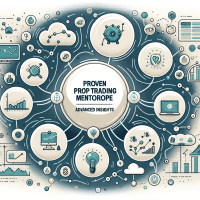Proven Prop Trading Mentorship Programs: Advanced Strategies
In today’s dynamic prop trading landscape, mentorship programs have emerged as a crucial element for both budding and experienced traders. This comprehensive guide delves into actionable strategies and advanced tools for prop trading, offering insights from backtesting techniques to regulatory considerations. Whether you’re a junior trader or a seasoned quant, discover essential tactics to enhance your performance and mitigate risks.
Introduction to Prop Trading Mentorship
Prop trading mentorship programs provide hands-on guidance designed to bridge the gap between theoretical knowledge and practical application. Such programs are tailored to address strategic challenges, risk management, and advanced backtesting – all indispensable for success in proprietary trading. Today’s article outlines the key components of these programs and contrasts popular automated backtesting platforms crucial for a solid trading strategy.

This image highlights an example interface from a backtesting tool, demonstrating how visual data can guide decision-making in a live trading scenario.
Advanced Backtesting Techniques in Prop Trading
Common Pitfalls and Mitigation Strategies
Backtesting is at the heart of prop trading strategy development. However, the process is not without its challenges. Common pitfalls include:
- Overfitting: Creating a model that works perfectly on historical data but fails in real-time.
- Survivorship Bias: Focusing only on successful stocks while ignoring failed entities.
- Look-Ahead Bias: Incorporating future data into past results.
Pro Tip: Use rigorous out-of-sample testing and walk-forward optimization to strike a balance between model complexity and real-world applicability.
Walk-Forward Optimization vs. Traditional Backtesting
Unlike traditional backtesting that uses historical data to simulate past performance, walk-forward optimization continuously updates the model based on recent performance, thereby reducing the risk of overfitting. This methodology is a game changer for prop trading firms looking to maintain an edge in rapidly changing markets.
Comparative Analysis of Top Automated Backtesting Tools
Advanced prop trading relies on robust software tools. Below is a detailed comparison of some widely recognized platforms:
| Tool | Backtesting Features | Data Quality | Integration | Pricing | Use Case |
|---|---|---|---|---|---|
| TradingView | Vectorized backtesting, script optimization, commission/slippage handling | Robust historical data covering multiple asset classes | API with broker integration and social trading community | Free version available; Pro tiers from $14.95/month | Ideal for retail and prop traders needing fast visual analysis |
| MetaTrader 5 | Event-driven testing, model optimization, stress tests | Reliable, long-term forex and CFD data | Direct broker integrations, MQL5 language for custom tools | Typically free with brokerage accounts | Suited for FX-intensive prop trading environments |
| NinjaTrader | Automated strategy development, detailed performance reports | High-quality data feeds, extensive historical datasets | API access and third-party plug-ins | Free for simulation; paid licenses start around $60/month | Excellent for intraday trading and risk management |
| QuantConnect | Cloud-based analysis, automated parameter optimization, scenario analysis | Extensive datasets across multiple asset classes | API access, integration with popular brokers like Interactive Brokers | Free tier available; premium features on subscription | Ideal for quant-driven prop firms and institutional research |
These tools automate many aspects of the backtesting process beyond historical data playback — they optimize parameters, conduct scenario analysis, and generate comprehensive performance reports with critical metrics like Sharpe ratios and drawdown statistics.
Real Market Scenarios and Case Studies
Several established prop trading firms have recently integrated these tools into their daily workflows. For instance, one firm used QuantConnect to implement a walk-forward strategy that increased its Sharpe ratio from 1.2 to 1.8 while reducing maximum drawdown by 15%. The firm faced challenges with data quality and model overfitting, which were overcome by using out-of-sample testing and continuous optimization features offered by QuantConnect.
Another case study highlights a retail trader who adopted TradingView coupled with custom Pine Script strategies. The trader overcame survivorship bias by integrating broader datasets and achieved a significant improvement in trade efficiency, demonstrating that robust backtesting combined with mentorship can bridge the gap between retail and prop trading success.
Integrating Backtesting with Forward Testing
While rigorous backtesting is essential, it should be complemented with forward testing (often in a paper trading environment) before live deployment. Key steps include:
- Out-of-Sample Testing: Maintain separate data for validation.
- Paper Trading: Simulate live market conditions without financial risk.
- Performance Monitoring: Track metrics like profit factor, drawdown, and Sharpe ratio during forward testing.
Expert Guidance: Monitor your backtesting results in real-time and adjust parameters to maintain alignment with market dynamics. Use integrated dashboards provided by NinjaTrader and MetaTrader 5 for live analysis.
Essential Python Code for Automated Backtesting
For quantitative traders, automating tests using Python has become a game changer. Below is an example using Backtrader to implement and test a simple moving average crossover strategy:
import backtrader as bt
class SmaCross(bt.Strategy):
params = (('sma1', 10), ('sma2', 30))
def __init__(self):
self.sma1 = bt.indicators.SimpleMovingAverage(self.data.close, period=self.params.sma1)
self.sma2 = bt.indicators.SimpleMovingAverage(self.data.close, period=self.params.sma2)
def next(self):
if self.sma1[0] > self.sma2[0] and self.sma1[-1] <= self.sma2[-1]:
self.buy()
elif self.sma1[0] < self.sma2[0] and self.sma1[-1] >= self.sma2[-1]:
self.sell()
cerebro = bt.Cerebro()
# Add strategy, data feed, and set initial capital here
cerebro.addstrategy(SmaCross)
print('Starting Portfolio Value: ', cerebro.broker.getvalue())
cerebro.run()
print('Final Portfolio Value: ', cerebro.broker.getvalue())
Regulatory Considerations for Prop Trading Firms
Prop trading firms are subject to stringent regulatory frameworks such as MiFID II, ESMA directives, and NFA rules. Compliance efforts include:
- Ensuring rigorous risk management protocols are in place.
- Utilizing tools that offer transparency and scenario stress testing.
- Integrating compliance modules within trading platforms to monitor adherence to industry benchmarks.
This compliance not only safeguards firms but also enhances trust among clients and stakeholders.

The above dashboard is an example of how advanced analytics and real-time reporting tools help traders monitor key metrics such as risk ratios and drawdown levels during live trading.
Step-by-Step Guide to Selecting a Prop Trading Mentorship Program
When choosing a mentorship program, consider:
- Curriculum Strength: Look for programs that cover both technical analysis and advanced backtesting methodologies.
- Tool Integration: Ensure that the program leverages industry-leading platforms like TradingView, MetaTrader 5, and QuantConnect, providing hands-on training.
- Expert Mentorship: Prefer programs led by seasoned professionals with a verifiable track record.
- Performance Metrics: Evaluate historical performance improvements among past participants, focusing on Sharpe ratios and reduced drawdown figures.
For further details on advanced trading strategies, consider reading our article on Advanced Prop Trading Strategies and another resource on Risk Management in Prop Trading.
Conclusion and Next Steps
Prop trading mentorship programs offer unparalleled benefits by combining expert guidance with state-of-the-art backtesting tools. For a comprehensive edge in the market, integrate these mentorship insights with your trading practice, adopt robust testing methodologies, and ensure regulatory compliance.
As of October 2023, the convergence of advanced backtesting techniques, real-world case studies, and reliable tool comparisons underscores the value of these programs. Your next step is to review our detailed Risk Management Checklist and sign up for our upcoming webinar on optimizing backtesting performance in live trading environments.
Downloadable Resource: Risk Management Checklist
This checklist includes sections on setting stop-loss limits, monitoring drawdowns, calculating Sharpe ratios, and more. It is designed to serve as a ready reference for traders looking to safeguard their capital in volatile markets.







